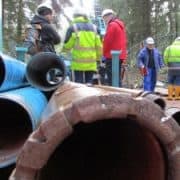Lithium Australia Completes VSPC Acquisition and Identifies Lithium in Lepidolite Hill Waste
THE BOURSE WHISPERER: Lithium Australia (ASX: LIT) has completed procurement of advanced cathode material production technology by way of acquiring 99.7 per cent of technology company VSPC.
Lithium Australia took over the Brisbane-based VSPC, which has spent 14 years and approximately $30 million developing some of the world’s most advanced manufacturing techniques to produce cathode materials.
LIT explained these materials are critical components of lithium-ion batteries, the growing demand for which is currently driven by rapidly increasing demand for EVs and consumer electronics.
The advanced battery materials being developed by VSPC are also applicable to green energy solutions, including as back-up for sources of renewable energy.
Since completing the takeover in February, LIT has undertaken re-commissioning of the company’s cathode plant, including negotiating time-critical service agreements, recruitment of technical and operating staff and service agreements have been arranged with universities to support the technical demands of the project.
The VSPC facility is a two to four tonnes-per-annum pilot plant, incorporating an integrated laboratory, coin-cell production facility and battery-testing equipment.
LIT indicated that plant inspections and servicing are underway, as is evaluation of equipment upgrades, to prepare for resumption of production in July 2018.
“Recommissioning the VSPC pilot plant is a challenging task, but many of the past scientific and operating staff have made themselves available to ensure success,” Lithium Australia managing director Adrian Griffin said in the company’s announcement to the Australian Securities Exchange.
“We welcome their assistance and participation in our plan to provide the world’s battery producers with the best available cathode materials.”
Lithium Australia has also completed further testwork on ore-sorting products from its Lepidolite Hill lithium project that it said indicates successful separation of lithium micas using an X-ray transmission ore-sorting method.
The company said existing stockpiles at Lepidolite Hill are potentially an attractive source of feed for its proposed large-scale pilot plant (LSPP), either as supplementary feed or a major source of feed.
On the basis of these initial results Lithium Australia believes potential exists to not only separate out petalite, as well as lepidolite, from surface stockpiles but also to undertake further exploration at the project; the latter would target possible in-situ lithium resources outside and/or below the current historic open-pit mine workings.
“Although our aim at Lepidolite Hill is exploitation of lithium mica, it’s not surprising to find such abundant petalite in the mine dumps,” Griffin said.
“Lepidolite Hill operated as a petalite mine in the 1970s, and perhaps the recovery of the target minerals was not as good as the operators would have liked!
“Ore-sorting will certainly enhance rapid separation of the lepidolite.
“That said, we’ll also devote significant attention to the recovery of other lithium minerals that result in a grade of about 1.8 per cent lithium dioxide in the reject material.
“We’ll probably drill at the south end of the existing pit, to see how far the lithium mineralisation extends beyond what was left in the pit wall.”
Email: info@lithium-au.com
Website: www.lithium-au.com





